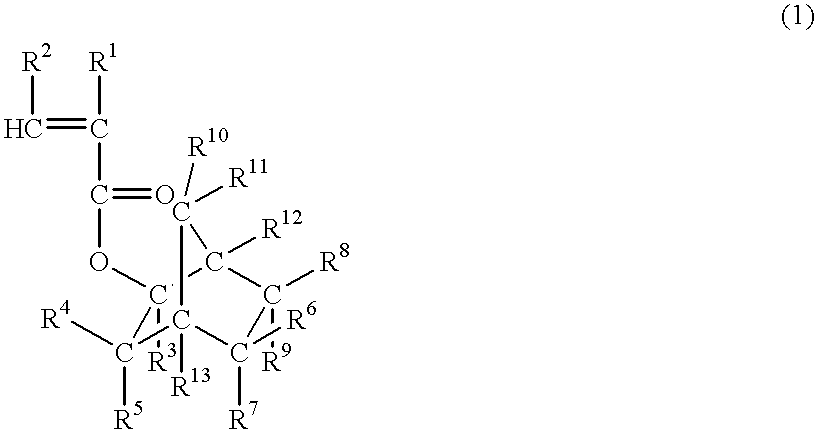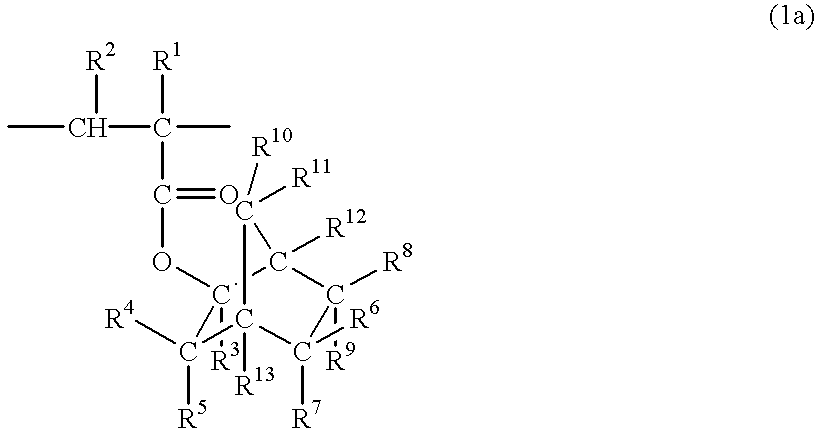Ester compounds, polymers, resist compositions and patterning process
a technology of resist composition and compound, applied in the direction of photosensitive materials, bulk chemical production, instruments, etc., can solve the problems of high rate of dissolution in unexposed areas, no acid eliminatable protective group is deemed to exert satisfactory performance, and the film thinning during developmen
- Summary
- Abstract
- Description
- Claims
- Application Information
AI Technical Summary
Problems solved by technology
Method used
Image
Examples
synthetic example 1-1
Synthesis of Monomer 1
In 600 ml of tetrahydrofuran was dissolved 148.5 g of ethyl bromide. Below 60.degree. C., this reaction mixture was added dropwise to 32.4 g of metallic magnesium over one hour. After agitation was continued for 2 hours at room temperature, 150.0 g of tricyclo[5.2.1.0.sup.2,6 ]decan-8-one was added dropwise over 45 minutes to the reaction mixture which was kept below 65.degree. C. After agitation was continued for one hour at room temperature, the reaction solution was worked up in a conventional manner. The resulting oily substance was distilled in vacuum, collecting 157.7 g of 8-ethyltricyclo[5.2.1.0.sup.2,6 ]decan-8-ol in endo-form. The yield was 87.6%.
In 600 ml of benzene was dissolved 155.0 g of 8-ethyltricyclo[5.2.1.0.sup.2,6 ]decan-8-ol in endo-form. To the solution was added 8.2 g of p-toluenesulfonic acid monohydrate. This reaction mixture was heated, agitated under reflux for 6 hours while removing water, and subjected to conventional post-treatment. ...
synthetic example 1-2
Synthesis of Monomer 2
By following the same procedure as above, 8-isopropyltricyclo[5.2.1.0.sup.2,6 ]decan-8-yl methacrylate in exo-form, designated Monomer 2, was synthesized from tricyclo[5.2.1.0.sup.2,6 ]decan-8-one.
.sup.1 H-NMR (CDCl.sub.3, 270 MHz):0.97 (d, 3H), 1.06 (d, 3H), 0.85-1.45 (6H, m), 1.60-2.10 (10H, m), 2.22 (dd, 1H), 3.02 (m, 1H), 5.45 (m, 1H), 5.99 (m, 1H)
FT-IR: 2956, 2864, 1713, 1637, 1450, 1319, 1300, 1182, 1157 cm.sup.-1
synthetic example 1-3
Synthesis of Monomer 3
By following the same procedure as above, 8-methyltricyclo[5.2.1.0.sup.2,6 ]decan-8-yl methacrylate in exo-form, designated Monomer 3, was synthesized from tricyclo[5.2.1.0.sup.2,6 ]decan-8-one.
.sup.1 H-NMR (CDCl.sub.3, 270 MHz): .delta.0.85-1.05 (m, 2H), 1.21 (m, 1H), 1.30 (dd, 1H), 1.35 (m, 1H), 1.46 (m, 1H), 1.56 (s, 3H), 1.60-2.15 (m, 10H), 2.39 (m, 1H), 5.46 (m, 1H), 5.99 (m, 1H)
FT-IR: 2949, 2864, 1711, 1637, 1450, 1331, 1303, 1174, 1151, 1054 cm.sup.-1
PUM
| Property | Measurement | Unit |
|---|---|---|
| Power | aaaaa | aaaaa |
| Volumetric flow rate | aaaaa | aaaaa |
| Volumetric flow rate | aaaaa | aaaaa |
Abstract
Description
Claims
Application Information
 Login to View More
Login to View More - R&D
- Intellectual Property
- Life Sciences
- Materials
- Tech Scout
- Unparalleled Data Quality
- Higher Quality Content
- 60% Fewer Hallucinations
Browse by: Latest US Patents, China's latest patents, Technical Efficacy Thesaurus, Application Domain, Technology Topic, Popular Technical Reports.
© 2025 PatSnap. All rights reserved.Legal|Privacy policy|Modern Slavery Act Transparency Statement|Sitemap|About US| Contact US: help@patsnap.com



